Data-Driven Optimization in Aerospace Composites Manufacturing
In its continuous pursuit of efficiency and performance, the aerospace industry has increasingly turned to plastic and composite materials. Plastics and composites offer significant advantages over traditional materials like metal. Advanced lightweight plastics and composites translate to improved fuel efficiency, while their design flexibility allows for innovative and aerodynamic shapes with reduced part count.
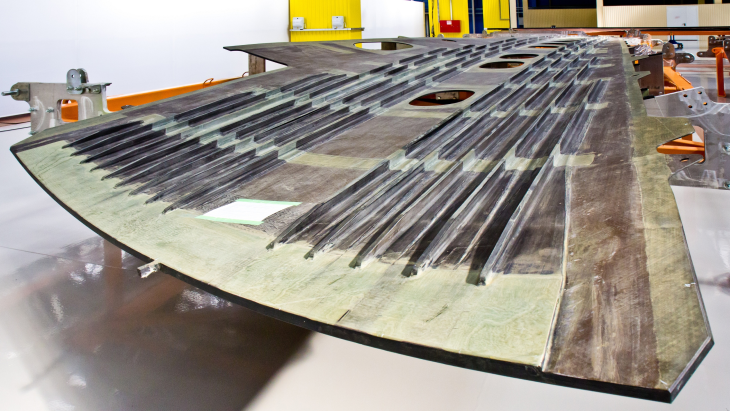
However, the development of new processes to account for advanced plastics and composites leads to challenges in balancing innovation with the stringent safety requirements demanded in aerospace manufacturing. Every component, from engines to cabin fixtures, must meet strict qualifications.
Certification agencies require robust evidence and documentation to ensure that any process optimizations, adoption of new materials, or implementations of novel techniques do not compromise the safety of an aircraft.
This article explores the balancing act of pushing boundaries in aerospace manufacturing while providing the evidence and data needed to gain certification approval. Further along, we will also present a collaborative project conducted by Wichita State University’s National Institute for Aviation Research (NIAR) using sensXPERT’s technology to tackle the challenge of composites manufacturing optimization for the aviation industry.
The Stringent World of Aerospace Qualifications
Safety is paramount in the aerospace industry. A single point of failure in a critical component can have detrimental consequences. This relentless focus on safety translates to a rigorous qualification process for aerospace products, from the materials they are composed of to the entire manufacturing process itself.
Regulatory Bodies
Several regulatory bodies, such as the FAA and the EASA, oversee the safety and airworthiness of aircraft.
The Federal Aviation Administration (FAA) is the governing body for all civil aviation in the United States. They set rigorous standards for aircraft design, manufacturing, and operation. Manufacturers seeking to supply components for US-made aircraft must comply with FAA regulations. The counterpart to the FAA in Europe is the European Union Aviation Safety (EASA), which ensures the safety of civil aviation within the European Union.
Both regulatory bodies act as the gatekeepers of safety when it comes to the safe use of materials, such as plastics and composites, in aerospace manufacturing. These agencies enforce regulations outlining the qualification processes for these materials.
Furthermore, these processes might involve flammability testing, mechanical property testing, and environmental exposure testing to ensure the materials can withstand the demanding conditions experienced by aircraft.
By adhering to these regulations and guidelines, manufacturers can gain approval for using certain plastics and composites in critical aerospace components, fostering innovation while maintaining the safety standards set by the industry.
Industry Standards
Beyond the regulations set by individual governing bodies, the aerospace industry relies heavily on established industry standards to ensure consistent quality and safety across the board. A prominent example is the AS9100 series of standards.
This internationally recognized standard outlines the specific requirements for a Quality Managment System (QMS) specifically tailored to the aerospace industry. By adhering to AS9100, manufacturers demonstrate a commitment to achieving and maintaining the highest quality and safety standards throughout every stage of production, from material selection to final assembly.
Certification to AS9100 by an accredited body is often a prerequisite when supplying parts to major aerospace companies.
Challenges and Solutions: Aerospace Process Optimization
The qualifications demanded by the aerospace industry, while necessary for ensuring quality and safety, challenge manufacturers seeking to optimize processes, materials, and techniques. Innovation is crucial to driving efficiency and performance, but proving the efficacy and safety of new approaches can be a significant hurdle.
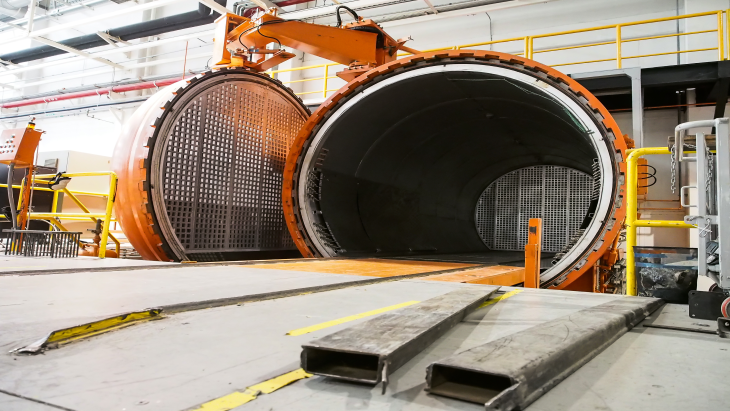
For one, new processes, materials, and techniques must undergo extensive testing and evaluation to demonstrate they meet the demanding safety and performance standards of the industry. This can be a time-consuming and expensive endeavor, requiring specialized equipment and expertise.
Additionally, manufacturers must provide irrefutable evidence that the proposed optimization delivers the desired results without compromising safety or performance. This evidence needs to be documented meticulously and presented in a format that regulatory bodies and certification agencies can readily understand and evaluate.
Moreover, optimization often involves integrating new technologies or materials into existing production lines. Manufacturers must demonstrate compatibility with established processes and ensure seamless integration without disrupting overall quality control procedures.
These challenges can stifle innovation and hinder the adoption of new technologies in plastics manufacturing. However, advancements in monitoring and characterization techniques embodied by solutions like sensXPERT Digital Mold are empowering manufacturers to overcome these challenges and achieve evidence-based advancements.
Real-Time Cure Monitoring with Digital Mold
Aerospace composites manufacturers can gain a significant edge with sensXPERT Digital Mold, which is a solution that allows for in-mold cure monitoring, material characterization, and deviation detection. This solution uses dielectric sensors, an industrial PC – Edge Device – and a couple of software components to help manufacturers achieve dynamic process control.
Throughout curing cycles, the sensors collect real-time data on in-mold material behavior and send the data to the Edge Device. The Edge Device then translates the collected data into critical material parameters, including degree of cure or crystallization, glass transition temperature, gel point, and flow behavior.
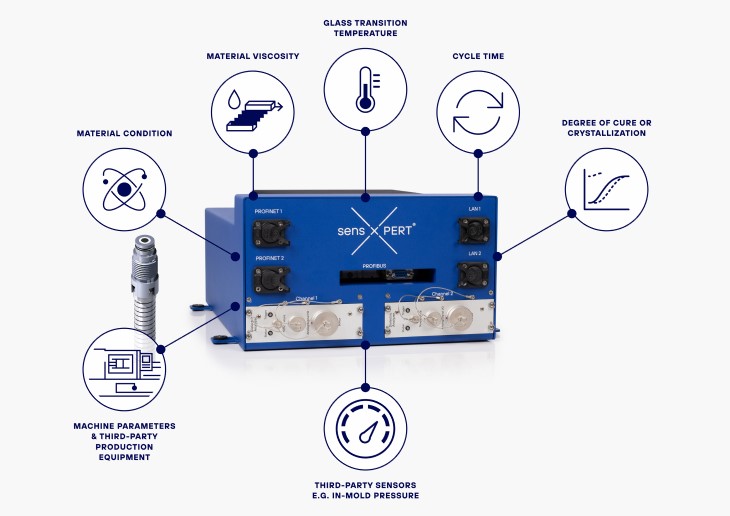
This generates several key benefits.
Validation of Optimized Curing Processes: When implementing faster or more efficient curing cycles, manufacturers can leverage the in-mold sensor data to verify that the material has reached the necessary degree of cure or crystallization for optimal strength and performance. This data becomes crucial evidence for certification bodies, demonstrating the efficacy of the proposed optimization.
Comprehensive Material Characterization: Successful material adoption in aerospace applications hinges on a thorough understanding of the material’s properties. sensXPERT’s Digital Mold technology goes beyond static, pre-production material characterization lab tests or reactive adjustments based on undesirable results in downstream quality assurance (QA) testing. Instead, machine operators can use sensXPERT’s real-time data to proactively fine-tune their curing cycles, leading to a more efficient and effective process.
Proactive Deviation Detection and Predictive Quality Control: sensXPERT’s Digital Mold goes a step further than simply monitoring cure progress. By continuously tracking critical material parameters, it offers real-time, in-mold deviation detection. Advanced algorithms analyze the data to identify potential anomalies in material behavior. This allows for immediate corrective actions during the curing process itself, minimizing the risk of producing non-conforming parts and reducing costly material waste.
Overall, the strict requirements of the aerospace industry place a heavy burden of proof on manufacturers seeking to implement innovative materials and processes. Traditionally, demonstrating the efficacy and safety of these advancements is time-consuming and expensive.
However, sensXPERT enables manufacturers to capture real-time data on critical material parameters throughout their entire curing cycles for each part produced. Thus, sensXPERT builds a comprehensive data set that empowers manufacturers to navigate the regulatory bodies’ approval processes.
Additionally, this granular data not only validates the repeatability and consistency of new processes but also provides concrete evidence to support the adoption of faster cure cycles or other optimizations.
The sensXPERT x NIAR Collaboration
A collaborative project between sensXPERT and NIAR’s Advanced Technologies Lab for Aerospace Systems (ATLAS) exemplifies the pursuit of optimization in aerospace manufacturing.
About NIAR and ATLAS
NIAR is a large, applied research institute that supports numerous aviation industry partners in the development of their production processes.
More specifically, NIAR provides research, design, testing, certification and training to the aviation and manufacturing industries and government agencies including the U.S. Department of Defense. NIAR’s mission is to strengthen university research capabilities; provide applied learning opportunities for students; and support the aviation and manufacturing industries – while driving innovation and prosperity for the community, region and state.
ATLAS is a makerspace for industry-scale automated manufacturing research including automated fiber placement (AFP), fiber patch placement for complex geometries, thermoplastic welding, and thermoplastic over-molding for multi-functional integrated structures.
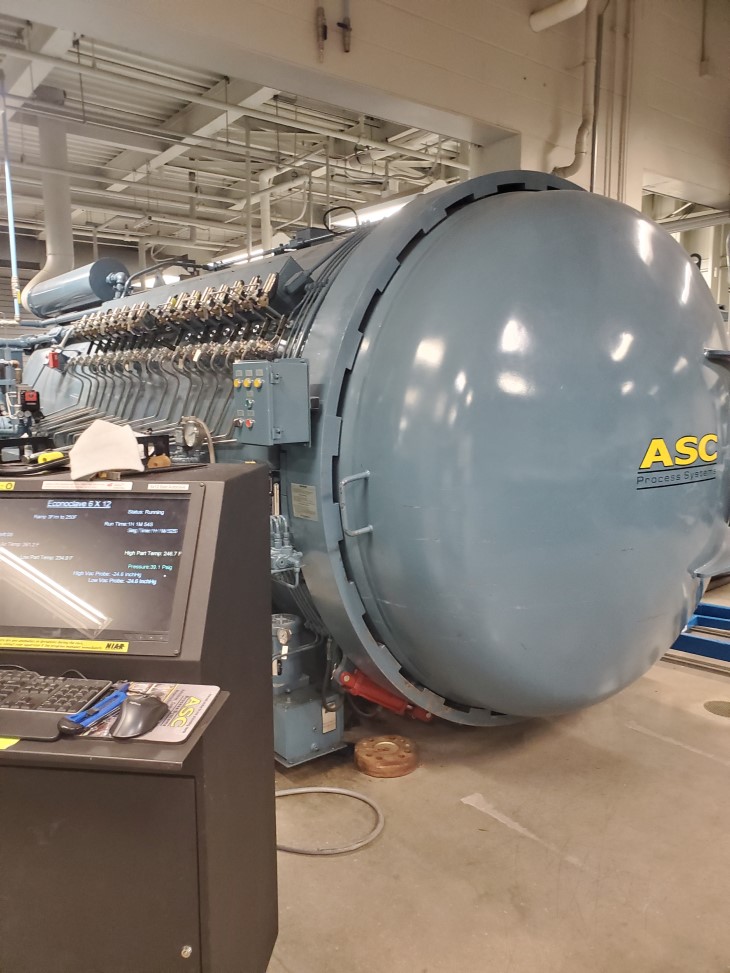
The sensXPERT x NIAR Project
Optimizing the curing process for composites in aerospace applications remains a challenge. Therefore, the NIAR x sensXPERT project focuses on precisely tracking the curing behavior of pre-impregnated (prepreg) carbon fiber, a material commonly used in aerospace structures.
Prepreg materials arrive with resin already infused into the carbon fiber sheets, but often in a partially uncured state. The NIAR research team utilizes sensXPERT to monitor the curing process as these prepreg materials, placed within a vacuum bag, are cured in an oven. A key focus is on tracking viscosity changes and the wet-out process, which determines how effectively the resin saturates the carbon fibers.
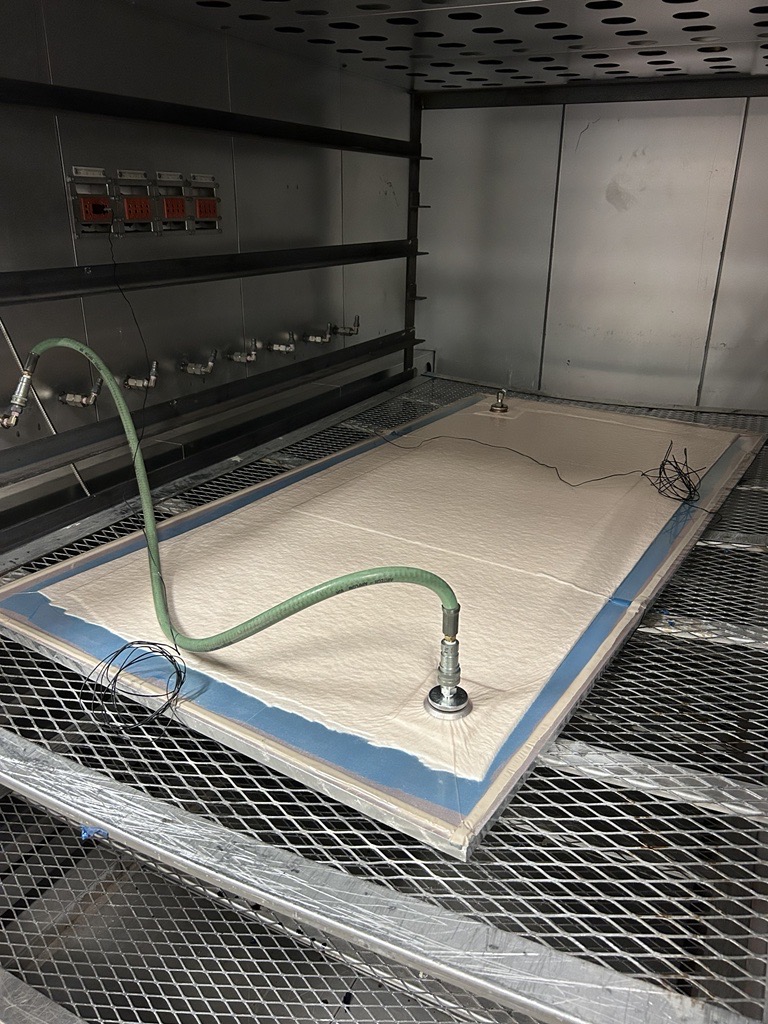
This collaborative effort aims to achieve two primary objectives. Firstly, the research team will evaluate the effectiveness of sensXPERT’s dielectric cure monitoring technology in comparison to traditional rheometers – instruments commonly used to measure viscosity.
Secondly, and most importantly for the aerospace industry, this project seeks to empower manufacturers with the data they need to optimize composite part production and gain certification approval for their composite parts. Traditionally, cure cycles are often based on generic material datasheets, regardless of the specific part dimensions.
sensXPERT Digital Mold, by capturing the exact curing behavior of each part, provides manufacturers with additional data to present to certification bodies. This detailed data can help build a strong case for process optimization specific to individual parts, potentially paving the way for more efficient and lighter aircraft structures without compromising safety standards set forth by regulatory bodies like the FAA.
This project exemplifies how sensXPERT Digital Mold addresses a critical challenge in the aerospace industry. By providing comprehensive material and process data and facilitating process optimization, sensXPERT empowers manufacturers to innovate and contribute to the development of next-generation aerospace vehicles.